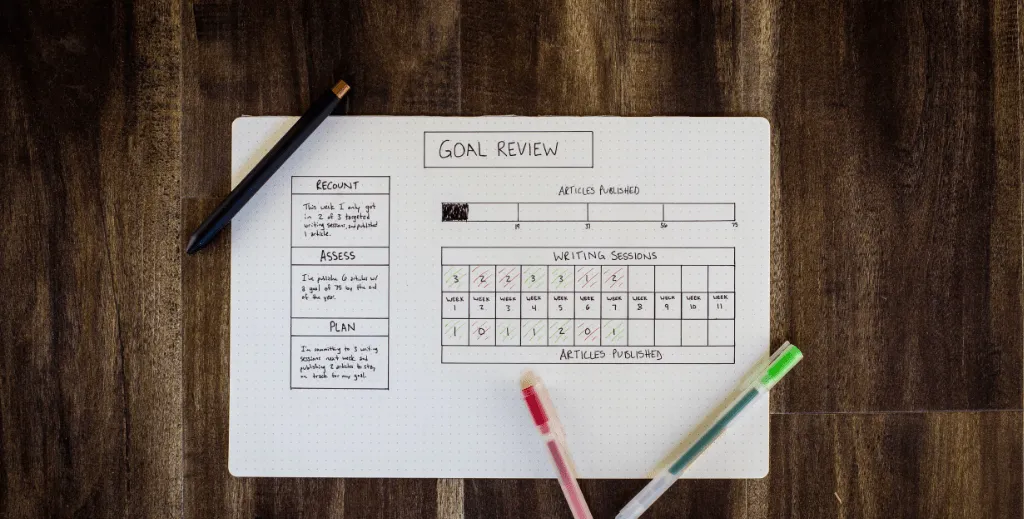How to Set Goals for Your Team – 6 Steps with Examples

Setting goals for your team is an essential part of achieving success in any business or organization. In our previous part of this series, we looked at how to build a high-performing team and goals are a key part of that. Goals provide direction, focus, and motivation for team members, and help to ensure that everyone is working toward a common purpose. However, setting effective goals requires careful planning and consideration.
To set goals for your team, you need to identify key performance indicators (KPIs) that are relevant to your business or organization. These KPIs should be specific, measurable, achievable, relevant, and time-bound (SMART). Once you have identified your KPIs, you can use them to set realistic and achievable goals for your team.
Additionally, you should also try to align team goals and individual goals so that your entire organization is working as one. Doing this represents a challenge to managers, however, getting started with both team and individual goals is easier than you might think!
So, to ensure your team is on the same page and each member is contributing effectively, here, we discuss the difference between individual and team goals, walk you through 6 steps to help you set team goals, and give you ten concrete examples of what those goals might look like. Read on to learn more with Spike.
Getting Started with Setting Goals for Your Team
Goals are a vital part of a productive work environment, and when implemented correctly, they can increase engagement and motivation across your team. The right goals can help individuals boost their overall effort and increase focus, and allow team members to prioritize their work. A lack of goals, or poorly set goals, on the other hand, can reduce focus, lower morale due to staff feeling less secure in their roles, and ultimately decrease productivity.
However, it can be challenging for a manager to know exactly what goals to set and how to set them, which is compounded by the fear that poorly set goals can have a negative impact on both individuals and entire teams. That said, it’s not as hard as you might think, but first, its crucial to understand the difference between team and individual goals, and how they can work together.
Team vs Individual Goals
Team and individual goals are often interrelated, and yet, the difference between the two is an important distinction to make. While individual and team goals serve different purposes in an organization, they can be leveraged to support each other when thinking about the overall direction of your business or organization.
Individual Goals:
Individual goals are usually set for employees during performance evaluations or as part of ongoing performance management. These goals are specific to each employee and are intended to help them develop their skills and improve their performance in their role. Individual goals may be related to specific tasks or projects, personal development, or career growth.
Team Goals
In contrast, team goals are set for a group of individuals who work together to achieve a common objective. Team goals are typically broader in scope than individual goals and are intended to align the efforts of team members towards a shared purpose. Team goals may be related to sales targets, customer satisfaction, productivity, or other key performance indicators.
Put simply, where individual goals are focused on the performance and development of individual employees, team goals are focused on the collective performance and achievement of the team as a whole. However, these differences can then feed into one another, and aligning the two can enhance each and allow your business or organization to achieve greater success over the long term.
For example, let’s say that a sales team has a team goal to increase the company’s revenue by 20% in the next quarter. To achieve this goal, the team members need to work together to identify new opportunities, develop strategies for closing deals, and collaborate effectively to ensure that all sales efforts are aligned towards the set goal.
At the same time, each sales team member has individual goals related to their performance and development. For example, one team member might have a goal to improve their product knowledge, while another may be working on improving their negotiation skills.
These individual goals can support the team goal in several ways, for instance:
-
•
A team member who improves their product knowledge can share their expertise with the rest of the team, which can help the team to identify new opportunities and close more deals.
-
•
A team member who improves their negotiation skills can help the team to close deals more effectively and increase revenue.
-
•
A team member who achieves their individual goals can feel more motivated and engaged, which can contribute to the overall success of the team.
Now that we’ve outlined the differences and commonalities of individual and team goals, check out our six steps in setting team goals and get started today!
6 Steps to Setting Team Goals

1. What Do You Want to Achieve? Write it Down
The first step to setting effective and actionable goals is figuring out exactly what you want to achieve, or in other words, your organizational objectives. Having clearly defined high-level objectives will help you to figure out the smaller goals your team will need to hit in order to achieve them.
Don’t just think about these organizational objectives; actually write them down—this can help create the mental space needed to come up with more actionable goals for your team later down the line. In fact, research has found that writing down objectives gives you an 80% higher chance of actually achieving them.
Some people are more visual when it comes to goal setting, in which case it might be advisable to post them clearly in the office. For digital teams, the same can be achieved through the use of collaborative online notes, allowing managers to visualize what they want and how to get there.
2. Set Team Level Goals
Setting team-level goals helps connect employees to company objectives while also fostering collaboration between team members for a more cohesive work environment. These goals act as a stepping-stone between individual tasks and the ultimate objectives of the company.
When creating these team-level goals, consider using some sort of goal productivity system such as SMART. This will help keep your objectives focused and achievable. Most importantly, to set team-level goals, you need to involve your team in the goal-setting process.
Another way of effective goal setting is understanding your team’s strengths and areas for improvement. Conducting an IQ Test can be a valuable tool in this process. It can help identify the skills and capabilities of team members, allowing you to tailor goals that leverage their strengths and address any weaknesses.
3. Team Participation in Developing Goals is Crucial
Involving your team in group and individual goal development is essential since it will help them feel invested in the objectives of the project and the company as a whole. The process will require a high level of communication and collaboration but will ultimately result in far more robust goals.
Setting objectives in a collaborative way can encourage team members to figure out how they can work together to meet those goals, playing to their individual strengths for a more efficient workflow. This will ensure the team members are more engaged in the tasks at hand and make sure that all tasks are aligned with those who can achieve the best results.
4. Deadlines are an Important Part of Goal Setting
While deadlines might bring up bad memories of late-night college papers for some, they are an essential part of setting goals. Deadlines for goals can:
-
•
Ensure work is delivered on time.
-
•
Help individuals plan out their workflow.
-
•
Keep each person in line with the wider team and company.
-
•
Make sure people aren’t held up by delays from other team members.
-
•
Set expectations for what is needed of an individual, team, or department.
-
•
Help people prioritize.
This final point may be the most important since prioritization helps people feel more in control of their work, and subsequently, more engaged with it. What’s more, one study found that 63% of respondents reported that not knowing the work that was their priority was the single biggest waste of time.
That said, it’s important to make goals realistic and achievable. A simple way to ensure this is to develop them with your team, as mentioned above. Once deadlines are agreed on, map them onto a shared calendar to ensure all team members are up to date and accountable.
5. Track Progress – Make it Measurable
Tracking the progress of a goal can help to keep team members motivated, on track, and accountable. Additionally, it makes it more likely that people will achieve (and even surpass) the goal within the given time. Progress tracking is most easily achieved through the use of productivity software, in which small steps can be tracked in a visual way.
Making progress measurable can help stop tasks from feeling overwhelming by breaking them down into smaller parts while keeping people working in the right direction.
6. Offer Incentives (Compensation, Rewards & Recognition)
Incentives for achieving certain goals or milestones can be a powerful motivator. This is true of both individual incentives as well as team incentives and may consist of:
-
•
Compensation – bonuses, raises, etc.
-
•
Rewards – gifts, services, etc to more personalized options such as Custom Canvas Photo Prints. These can be especially effective for teams.
-
•
Recognition – praise, thanks, and even certificates.
It’s important to remember that bad incentives can be worse than no incentives at all since a low-effort reward or lack of recognition can make employees feel really undervalued. Tread carefully.
Setting Team Goals — 10 Examples
Now that we’ve outlined how you can set team goals in six steps, check out our examples of what they might look like and discover how you can tailor each to your business needs.
-
Increase sales revenue by 20% in the next quarter
This goal focuses on the team’s ability to generate more revenue for the company. To achieve this goal, the team may need to develop new sales strategies, improve customer retention, or explore new markets.
-
Improve customer satisfaction ratings by 15% within the next six months
This goal focuses on the team’s ability to create a positive experience for customers. To achieve this goal, the team may need to improve product quality, respond to customer feedback, or provide better customer service.
-
Launch a new product line by the end of the year
This goal focuses on the team’s ability to develop and launch a new product line. To achieve this goal, the team may need to conduct market research, design and develop the product, and create a marketing campaign to promote it.
-
Reduce customer complaint rates by 50% within the next three months
This goal focuses on the team’s ability to address and resolve customer complaints. To achieve this goal, the team may need to identify the root causes of complaints, implement solutions to address those issues, and monitor feedback to ensure improvements are effective.
-
Increase website traffic by 25% within the next six months
This goal focuses on the team’s ability to attract more visitors to the company’s website. To achieve this goal, the team may need to optimize website content for search engines, develop targeted advertising campaigns, or create more engaging content to keep visitors on the site.
-
Improve employee engagement scores by 10% within the next quarter
This goal focuses on the team’s ability to improve employee satisfaction and motivation. To achieve this goal, the team may need to conduct employee surveys, identify areas of concern, and develop strategies to improve communication, recognition, and other factors that impact engagement.
-
Develop a new marketing campaign and generate 100 new leads in the next month
This goal focuses on the team’s ability to create effective marketing campaigns that generate leads for the company. To achieve this goal, the team may need to research target audiences, develop compelling messaging, and use multiple channels to reach potential customers.
-
Reduce production costs by 15% within the next year
This goal focuses on the team’s ability to streamline operations and reduce expenses. To achieve this goal, the team may need to identify areas of waste, implement lean manufacturing or other efficiency strategies, and negotiate with suppliers for better pricing.
-
Improve delivery times by 20% within the next three months
This goal focuses on the team’s ability to improve delivery speed and reliability. To achieve this goal, the team may need to evaluate current processes, identify bottlenecks or delays, and implement changes to improve efficiency and reduce lead times.
-
Increase social media followers by 30% within the next six months
This goal focuses on the team’s ability to build a larger social media following for the company. To achieve this goal, the team may need to develop engaging content, use social media advertising, and collaborate with influencers or partners to expand reach.
Help Your Team Meet Their Goals

Good goal setting doesn’t end once people have their objectives. They need to be fostered, adapted, and monitored as the work moves forward. This will help to make your working environment more agile and able to respond to changes and new challenges as they arise.
On a practical note, if you’ve been following the points so far, you’re well on your way to helping your team meet their goals already. Setting out broader objectives and tracking progress is key for ongoing success, and as you move forwards, use each success and failure to learn and improve goals.
Learn from Past Mistakes and Success
Mistakes should be used as opportunities to learn. Look back and reflect on what worked and what didn’t during previous projects, as well as any goals currently being worked on. Don’t be afraid to put your hands up, admit you made a mistake, and change things in an ongoing process of improvement.
The same can be applied for success. We often analyze why something didn’t work in order to learn from mistakes but rarely take the time to consider why something did work so it can be replicated in the future.
Use Positive Reinforcement to Praise Success
It’s easy to flag issues when things go wrong, but we often overlook successes by putting it down to “just how things are supposed to run.” Yes, team members are responsible for hitting their targets, but it’s still a success when they do!
Take the time to praise the achievement of individual, team, and company goals. This will help to reinforce the idea that the work is valued, as well as making sure employees know that goals aren’t arbitrary. There is nothing more demoralizing than putting in the extra effort to hit a goal and then feeling like nobody noticed—and people will be far less likely to go the extra mile in the future.
Summary
A big part of setting effective goals for your team involves having your team weigh in during the decision-making process. This should be kept in mind throughout, as goals are set, designated, and worked towards. Morale is important, so make sure that success is celebrated and rewarded while mistakes are learned from. Overall, communicate closely with your team and respond to the real-world impact of goals. Of course, you can communicate more effectively by listening. The next part of our series focused on active listening.
Team Goal Setting FAQ's
Goals are an essential part of any successful project. Goals increase engagement and motivation, boost the overall effort and focus, and help team members prioritize their work.
- Establish good lines of communication and collaboration.
- Make them feel connected to wider company objectives.
- Give them the space and support needed to collaborate with colleagues.
- Help them learn from your mistakes – feedback success and failure from past projects.
Setting team goals doesn’t have to mean sitting around a conference table, taking turns to tell the group your idea. Consider using post-its so people can make a collaborative objective map or use a whiteboard to map out how each person sees the journey towards the final aims.
Just getting your team involved will already make setting team goals a less dull and disconnected process.
There are many ways that group goals can be celebrated, and it depends on your wider company culture and the individuals on your team. At a minimum, all achievements should be recognized and praised, but also consider whether rewards such as gifts or services might work.
Team goals help build cohesiveness, improve motivation and foster a culture of transparency. The best way to set team objectives is through a methodology such as SMART, in which each goal is:
- Specific
- Measurable
- Attainable
- Relevant
- Timely




